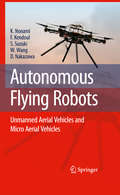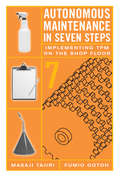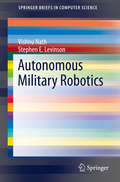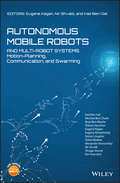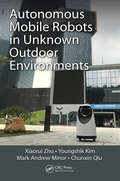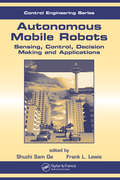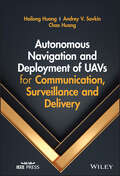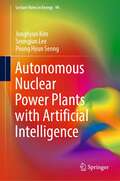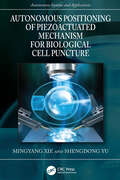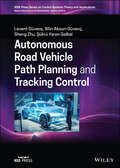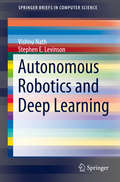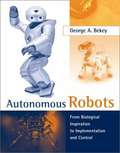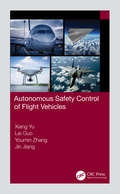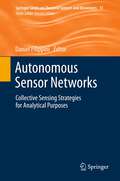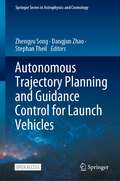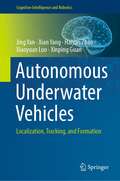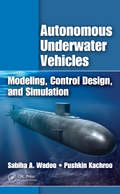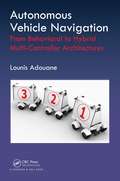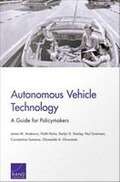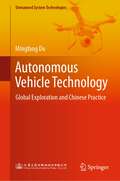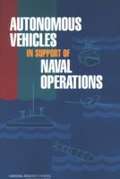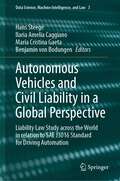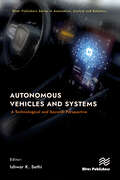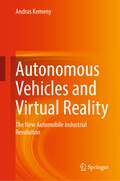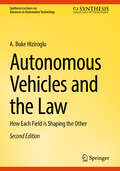- Table View
- List View
Autonomous Flying Robots: Unmanned Aerial Vehicles and Micro Aerial Vehicles
by Wei Wang Daisuke Nakazawa Farid Kendoul Kenzo Nonami Satoshi SuzukiWorldwide demand for robotic aircraft such as unmanned aerial vehicles (UAVs) and micro aerial vehicles (MAVs) is surging. Not only military but especially civil applications are being developed at a rapid pace. Unmanned vehicles offer major advantages when used for aerial surveillance, reconnaissance, and inspection in complex and inhospitable environments. UAVs are better suited for dirty or dangerous missions than manned aircraft and are more cost-effective. UAVs can operate in contaminated environments, for example, and at altitudes both lower and higher than those typically traversed by manned aircraft. Many technological, economic, and political factors have encouraged the development and operation of UAVs. New sensors, microprocessors, and propulsion systems are smaller, lighter, and more capable, leading to levels of endurance, efficiency, and autonomy that exceed human capacities. Comprising the latest research, this book describes step by step the development of small or miniature unmanned aerial vehicles and discusses in detail the integrated prototypes developed at the robotics laboratory of Chiba University. With demonstration videos, the book will interest not only graduate students, scientists, and engineers but also newcomers to the field.
Autonomous Maintenance in Seven Steps: Implementing TPM on the Shop Floor
by Fumio GotohAutonomous maintenance is an especially important pillar of Total Productive Maintenance (TPM) because it enlists the intelligence and skills of the people who are most familiar with factory machines-- equipment operators. Operators learn the maintenance skills they need to know through a seven-step autonomous maintenance program. Most companies in the West stop after implementing the first few steps and never realize the full benefits of autonomous maintenance. This book contains comprehensive coverage of all seven steps--not just the first three or four.It includes:An overview of autonomous maintenance features and checklists for step audits to certify team achievement at each AM step.TPM basics such as the six big losses, overall equipment effectiveness (OEE), causes of losses, and six major TPM activities.An implementation plan for TPM and five countermeasures for achieving zero breakdowns.Useful guidelines and case studies in applying AM to manual work such as assembly, inspection, and material handling.Integrates examples from Toyota, Asai Glass, Bridgestone, Hitachi, and other top companies.By treating machines as partners and taking responsibility for them, you get machines that you can rely on and help maintain an energized and responsive workplace. For companies that are serious about taking autonomous maintenance beyond mere cleaning programs, this is an essential sourcebook and implementation support.
Autonomous Military Robotics (SpringerBriefs in Computer Science)
by Vishnu Nath Stephen E. LevinsonThis SpringerBrief reveals the latest techniques in computer vision and machine learning on robots that are designed as accurate and efficient military snipers. Militaries around the world are investigating this technology to simplify the time, cost and safety measures necessary for training human snipers. These robots are developed by combining crucial aspects of computer science research areas including image processing, robotic kinematics and learning algorithms. The authors explain how a new humanoid robot, the iCub, uses high-speed cameras and computer vision algorithms to track the object that has been classified as a target. The robot adjusts its arm and the gun muzzle for maximum accuracy, due to a neural model that includes the parameters of its joint angles, the velocity of the bullet and the approximate distance of the target. A thorough literature review provides helpful context for the experiments. Of practical interest to military forces around the world, this brief is designed for professionals and researchers working in military robotics. It will also be useful for advanced level computer science students focused on computer vision, AI and machine learning issues.
Autonomous Mobile Robots and Multi-Robot Systems: Motion-Planning, Communication, and Swarming
by Eugene Kagan Irad Ben-Gal Nir ShvalbOffers a theoretical and practical guide to the communication and navigation of autonomous mobile robots and multi-robot systems This book covers the methods and algorithms for the navigation, motion planning, and control of mobile robots acting individually and in groups. It addresses methods of positioning in global and local coordinates systems, off-line and on-line path-planning, sensing and sensors fusion, algorithms of obstacle avoidance, swarming techniques and cooperative behavior. The book includes ready-to-use algorithms, numerical examples and simulations, which can be directly implemented in both simple and advanced mobile robots, and is accompanied by a website hosting codes, videos, and PowerPoint slides Autonomous Mobile Robots and Multi-Robot Systems: Motion-Planning, Communication and Swarming consists of four main parts. The first looks at the models and algorithms of navigation and motion planning in global coordinates systems with complete information about the robot’s location and velocity. The second part considers the motion of the robots in the potential field, which is defined by the environmental states of the robot's expectations and knowledge. The robot's motion in the unknown environments and the corresponding tasks of environment mapping using sensed information is covered in the third part. The fourth part deals with the multi-robot systems and swarm dynamics in two and three dimensions. Provides a self-contained, theoretical guide to understanding mobile robot control and navigation Features implementable algorithms, numerical examples, and simulations Includes coverage of models of motion in global and local coordinates systems with and without direct communication between the robots Supplemented by a companion website offering codes, videos, and PowerPoint slides Autonomous Mobile Robots and Multi-Robot Systems: Motion-Planning, Communication and Swarming is an excellent tool for researchers, lecturers, senior undergraduate and graduate students, and engineers dealing with mobile robots and related issues.
Autonomous Mobile Robots in Unknown Outdoor Environments
by Xiaorui Zhu Youngshik Kim Chunxin Qiu Mark MinorMobile robots have been increasingly applied in many different scenarios, such as space exploration and search and rescue, where the robots are required to travel over uneven terrain while outdoors. This book provides a new framework and the related algorithms for designing autonomous mobile robotic systems in such unknown outdoor environments.
Autonomous Mobile Robots: Sensing, Control, Decision Making and Applications (Automation and Control Engineering #22)
by Shuzhi Sam Ge and Frank L. LewisIt has long been the goal of engineers to develop tools that enhance our ability to do work, increase our quality of life, or perform tasks that are either beyond our ability, too hazardous, or too tedious to be left to human efforts. Autonomous mobile robots are the culmination of decades of research and development, and their potential is seemingly unlimited.Roadmap to the FutureServing as the first comprehensive reference on this interdisciplinary technology, Autonomous Mobile Robots: Sensing, Control, Decision Making, and Applications authoritatively addresses the theoretical, technical, and practical aspects of the field. The book examines in detail the key components that form an autonomous mobile robot, from sensors and sensor fusion to modeling and control, map building and path planning, and decision making and autonomy, and to the final integration of these components for diversified applications.Trusted GuidanceA duo of accomplished experts leads a team of renowned international researchers and professionals who provide detailed technical reviews and the latest solutions to a variety of important problems. They share hard-won insight into the practical implementation and integration issues involved in developing autonomous and open robotic systems, along with in-depth examples, current and future applications, and extensive illustrations.For anyone involved in researching, designing, or deploying autonomous robotic systems, Autonomous Mobile Robots is the perfect resource.
Autonomous Navigation and Deployment of UAVs for Communication, Surveillance and Delivery
by Andrey V. Savkin Chao Huang Hailong HuangAutonomous Navigation and Deployment of UAVs for Communication, Surveillance and Delivery Authoritative resource offering coverage of communication, surveillance, and delivery problems for teams of unmanned aerial vehicles (UAVs) Autonomous Navigation and Deployment of UAVs for Communication, Surveillance and Delivery studies various elements of deployment of networks of unmanned aerial vehicle (UAV) base stations for providing communication to ground users in disaster areas, covering problems like ground traffic monitoring, surveillance of environmental disaster areas (e.g. brush fires), using UAVs in rescue missions, converting UAV video surveillance, and more. The work combines practical problems, implementable and computationally efficient algorithms to solve these problems, and mathematically rigorous proofs of each algorithm’s convergence and performance. One such example provided by the authors is a novel biologically inspired motion camouflage algorithm to covert video surveillance of moving targets by an unmanned aerial vehicle (UAV). All autonomous navigation and deployment algorithms developed in the book are computationally efficient, easily implementable in engineering practice, and based only on limited information on other UAVs of each and the environment. Sample topics discussed in the work include: Deployment of UAV base stations for communication, especially with regards to maximizing coverage and minimizing interference Deployment of UAVs for surveillance of ground areas and targets, including surveillance of both flat and uneven areas Navigation of UAVs for surveillance of moving areas and targets, including disaster areas and ground traffic monitoring Autonomous UAV navigation for covert video surveillance, offering extensive coverage of optimization-based navigation Integration of UAVs and public transportation vehicles for parcel delivery, covering both one-way and round trips Professionals in navigation and deployment of unmanned aerial vehicles, along with researchers, engineers, scientists in intersecting fields, can use Autonomous Navigation and Deployment of UAVs for Communication, Surveillance and Delivery to gain general knowledge on the subject along with practical, precise, and proven algorithms that can be deployed in a myriad of practical situations.
Autonomous Nuclear Power Plants with Artificial Intelligence (Lecture Notes in Energy #94)
by Poong Hyun Seong Jonghyun Kim Seungjun LeeThis book introduces novel approaches and practical examples of autonomous nuclear power plants that minimize operator intervention. Autonomous nuclear power plants with artificial intelligence presents a framework to enable nuclear power plants to autonomously operate and introduces artificial intelligence (AI) techniques to implement its functions. Although nuclear power plants are already highly automated to reduce human errors and guarantee the reliability of system operations, the term “autonomous” is still not popular because AI techniques are regarded as less proven technologies. However, the use of AI techniques and the autonomous operation seems unavoidable because of their great advantages, especially, in advanced reactors and small modular reactors.The book includes the following topics:Monitoring, diagnosis, and prediction.Intelligent control.Operator support systems.Operator-autonomous system interaction.Integration into the autonomous operation system. This book will provides useful information for researchers and students who are interested in applying AI techniques in the fields of nuclear as well as other industries. This book covers broad practical applications of AI techniques from the classical fault diagnosis to more recent autonomous control. In addition, specific techniques and modelling examples are expected to be very informative to the beginners in the AI studies.
Autonomous Positioning of Piezoactuated Mechanism for Biological Cell Puncture (Autonomous Systems and Applications)
by Mingyang Xie Shengdong YuAutonomous Positioning of Piezoactuated Mechanism for Biological Cell Puncture gives a systematic and almost self-contained description of the many facets of advanced design, optimization, modeling, system identification, and advanced control techniques for positioning of the cell puncture mechanism with a piezoelectric actuator in micro/nanorobotics systems. To achieve biomedical applications, reliability design, modeling, and precision control are essential for developing engineering systems. With the advances in mechanical design, dynamic modeling, system identification, and control techniques, it is possible to expand the advancements in reliability design, precision control, and quick actuation of micro/nanomanipulation systems to the robot’s applications at the micro- and nanoscales, especially for biomedical applications. This book unifies existing and emerging techniques concerning advanced design, modeling, and advanced control methodologies in micropuncture of biological cells using piezoelectric actuators with their practical biomedical applications. The book is an essential resource for researchers within robotics, mechatronics, biomedical engineering, and automatic control society, including both academic and industrial parts. KEY FEATURES • Provides a series of latest results in, including but not limited to, design, modeling, and control of micro/nanomanipulation systems utilizing piezoelectric actuators • Gives recent advances of theory, technological aspects, and applications of advanced modeling, control, and actuation methodologies in cell engineering applications • Presents simulation and experimental results to reflect the micro/nano manipulation practice and validate the performances of the developed design, analysis, and synthesis approaches
Autonomous Road Vehicle Path Planning and Tracking Control (IEEE Press Series on Control Systems Theory and Applications)
by Levent Guvenc Bilin Aksun-Guvenc Sheng Zhu Sukru Yaren GelbalDiscover the latest research in path planning and robust path tracking control In Autonomous Road Vehicle Path Planning and Tracking Control, a team of distinguished researchers delivers a practical and insightful exploration of how to design robust path tracking control. The authors include easy to understand concepts that are immediately applicable to the work of practicing control engineers and graduate students working in autonomous driving applications. Controller parameters are presented graphically, and regions of guaranteed performance are simple to visualize and understand. The book discusses the limits of performance, as well as hardware-in-the-loop simulation and experimental results that are implementable in real-time. Concepts of collision and avoidance are explained within the same framework and a strong focus on the robustness of the introduced tracking controllers is maintained throughout. In addition to a continuous treatment of complex planning and control in one relevant application, the Autonomous Road Vehicle Path Planning and Tracking Control includes: A thorough introduction to path planning and robust path tracking control for autonomous road vehicles, as well as a literature review with key papers and recent developments in the area Comprehensive explorations of vehicle, path, and path tracking models, model-in-the-loop simulation models, and hardware-in-the-loop models Practical discussions of path generation and path modeling available in current literature In-depth examinations of collision free path planning and collision avoidance Perfect for advanced undergraduate and graduate students with an interest in autonomous vehicles, Autonomous Road Vehicle Path Planning and Tracking Control is also an indispensable reference for practicing engineers working in autonomous driving technologies and the mobility groups and sections of automotive OEMs.
Autonomous Robotics and Deep Learning (SpringerBriefs in Computer Science)
by Vishnu Nath Stephen E. LevinsonThis Springer Brief examines the combination of computer vision techniques and machine learning algorithms necessary for humanoid robots to develop "true consciousness. " It illustrates the critical first step towards reaching "deep learning," long considered the holy grail for machine learning scientists worldwide. Using the example of the iCub, a humanoid robot which learns to solve 3D mazes, the book explores the challenges to create a robot that can perceive its own surroundings. Rather than relying solely on human programming, the robot uses physical touch to develop a neural map of its environment and learns to change the environment for its own benefit. These techniques allow the iCub to accurately solve any maze, if a solution exists, within a few iterations. With clear analysis of the iCub experiments and its results, this Springer Brief is ideal for advanced level students, researchers and professionals focused on computer vision, AI and machine learning.
Autonomous Robots: From Biological Inspiration to Implementation and Control
by George A. BekeyAutonomous robots are intelligent machines capable of performing tasks in the world by themselves, without explicit human control. Examples range from autonomous helicopters to Roomba, the robot vacuum cleaner. In this book, George Bekey offers an introduction to the science and practice of autonomous robots that can be used both in the classroom and as a reference for industry professionals. He surveys the hardware implementations of more than 300 current systems, reviews some of their application areas, and examines the underlying technology, including control, architectures, learning, manipulation, grasping, navigation, and mapping. Living systems can be considered the prototypes of autonomous systems, and Bekey explores the biological inspiration that forms the basis of many recent developments in robotics. He also discusses robot control issues and the design of control architectures. After an overview of the field that introduces some of its fundamental concepts, the book presents background material on hardware, control (from both biological and engineering perspectives), software architecture, and robot intelligence. It then examines a broad range of implementations and applications, including locomotion (wheeled, legged, flying, swimming, and crawling robots), manipulation (both arms and hands), localization, navigation, and mapping. The many case studies and specific applications include robots built for research, industry, and the military, among them underwater robotic vehicles, walking machines with four, six, and eight legs, and the famous humanoid robots Cog, Kismet, ASIMO,"and QRIO. The book concludes with reflections on the future of robotics -- the potential benefits as well as the possible dangers that may arise from large numbers of increasingly intelligent and autonomous robots.
Autonomous Safety Control of Flight Vehicles
by Lei Guo Jin Jiang Xiang Yu Youmin ZhangAerospace vehicles are by their very nature a crucial environment for safety-critical systems. By virtue of an effective safety control system, the aerospace vehicle can maintain high performance despite the risk of component malfunction and multiple disturbances, thereby enhancing aircraft safety and the probability of success for a mission. Autonomous Safety Control of Flight Vehicles presents a systematic methodology for improving the safety of aerospace vehicles in the face of the following occurrences: a loss of control effectiveness of actuators and control surface impairments; the disturbance of observer-based control against multiple disturbances; actuator faults and model uncertainties in hypersonic gliding vehicles; and faults arising from actuator faults and sensor faults. Several fundamental issues related to safety are explicitly analyzed according to aerospace engineering system characteristics; while focusing on these safety issues, the safety control design problems of aircraft are studied and elaborated on in detail using systematic design methods. The research results illustrate the superiority of the safety control approaches put forward. The expected reader group for this book includes undergraduate and graduate students but also industry practitioners and researchers. About the Authors: Xiang Yu is a Professor with the School of Automation Science and Electrical Engineering, Beihang University, Beijing, China. His research interests include safety control of aerospace engineering systems, guidance, navigation, and control of unmanned aerial vehicles. Lei Guo, appointed as "Chang Jiang Scholar Chair Professor", is a Professor with the School of Automation Science and Electrical Engineering, Beihang University, Beijing, China. His research interests include anti-disturbance control and filtering, stochastic control, and fault detection with their applications to aerospace systems. Youmin Zhang is a Professor in the Department of Mechanical, Industrial and Aerospace Engineering, Concordia University, Montreal, Québec, Canada. His research interests include fault diagnosis and fault-tolerant control, and cooperative guidance, navigation, and control (GNC) of unmanned aerial/space/ground/surface vehicles. Jin Jiang is a Professor in the Department of Electrical & Computer Engineering, Western University, London, Ontario, Canada. His research interests include fault-tolerant control of safety-critical systems, advanced control of power plants containing non-traditional energy resources, and instrumentation and control for nuclear power plants.
Autonomous Sensor Networks: Collective Sensing Strategies for Analytical Purposes (Springer Series on Chemical Sensors and Biosensors #13)
by Daniel FilippiniThis volume surveys recent research on autonomous sensor networks from the perspective of enabling technologies that support medical, environmental and military applications. State of the art, as well as emerging concepts in wireless sensor networks, body area networks and ambient assisted living introduce the reader to the field, while subsequent chapters deal in depth with established and related technologies, which render their implementation possible. These range from smart textiles and printed electronic devices to implanted devices and specialized packaging, including the most relevant technological features. The last four chapters are devoted to customization, implementation difficulties and outlook for these technologies in specific applications.
Autonomous Trajectory Planning and Guidance Control for Launch Vehicles (Springer Series in Astrophysics and Cosmology)
by Zhengyu Song Stephan Theil Dangjun ZhaoThis open access book highlights the autonomous and intelligent flight control of future launch vehicles for improving flight autonomy to plan ascent and descent trajectories onboard, and autonomously handle unexpected events or failures during the flight. Since the beginning of the twenty-first century, space launch activities worldwide have grown vigorously. Meanwhile, commercial launches also account for the booming trend. Unfortunately, the risk of space launches still exists and is gradually increasing in line with the rapidly rising launch activities and commercial rockets. In the history of space launches, propulsion and control systems are the two main contributors to launch failures. With the development of information technologies, the increase of the functional density of hardware products, the application of redundant or fault-tolerant solutions, and the improvement of the testability of avionics, the launch losses caused by control systems exhibit a downward trend, and the failures induced by propulsion systems become the focus of attention. Under these failures, the autonomous planning and guidance control may save the missions. This book focuses on the latest progress of relevant projects and academic studies of autonomous guidance, especially on some advanced methods which can be potentially real-time implemented in the future control system of launch vehicles. In Chapter 1, the prospect and technical challenges are summarized by reviewing the development of launch vehicles. Chapters 2 to 4 mainly focus on the flight in the ascent phase, in which the autonomous guidance is mainly reflected in the online planning. Chapters 5 and 6 mainly discuss the powered descent guidance technologies. Finally, since aerodynamic uncertainties exert a significant impact on the performance of the ascent / landing guidance control systems, the estimation of aerodynamic parameters, which are helpful to improve flight autonomy, is discussed in Chapter 7. The book serves as a valuable reference for researchers and engineers working on launch vehicles. It is also a timely source of information for graduate students interested in the subject.
Autonomous Underwater Vehicles: Localization, Tracking, and Formation (Cognitive Intelligence and Robotics)
by Xinping Guan Xian Yang Jing Yan Haiyan Zhao Xiaoyuan LuoAutonomous underwater vehicles (AUVs) are emerging as a promising solution to help us explore and understand the ocean. The global market for AUVs is predicted to grow from 638 million dollars in 2020 to 1,638 million dollars by 2025 – a compound annual growth rate of 20.8 percent. To make AUVs suitable for a wider range of application-specific missions, it is necessary to deploy multiple AUVs to cooperatively perform the localization, tracking and formation tasks. However, weak underwater acoustic communication and the model uncertainty of AUVs make achieving this challenging. This book presents cutting-edge results regarding localization, tracking and formation for AUVs, highlighting the latest research on commonly encountered AUV systems. It also showcases several joint localization and tracking solutions for AUVs. Lastly, it discusses future research directions and provides guidance on the design of future localization, tracking and formation schemes for AUVs. Representing a substantial contribution to nonlinear system theory, robotic control theory, and underwater acoustic communication system, this book will appeal to university researchers, scientists, engineers, and graduate students in control theory and control engineering who wish to learn about the core principles, methods, algorithms, and applications of AUVs. Moreover, the practical localization, tracking and formation schemes presented provide guidance on exploring the ocean. The book is intended for those with an understanding of nonlinear system theory, robotic control theory, and underwater acoustic communication systems.
Autonomous Underwater Vehicles: Modeling, Control Design and Simulation
by Pushkin Kachroo Sabiha WadooUnderwater vehicles present some difficult and very particular control system design problems. These are often the result of nonlinear dynamics and uncertain models, as well as the presence of sometimes unforeseeable environmental disturbances that are difficult to measure or estimate. Autonomous Underwater Vehicles: Modeling, Control Design, and Simulation outlines a novel approach to help readers develop models to simulate feedback controllers for motion planning and design. The book combines useful information on both kinematic and dynamic nonlinear feedback control models, providing simulation results and other essential information, giving readers a truly unique and all-encompassing new perspective on design. Includes MATLAB® Simulations to Illustrate Concepts and Enhance Understanding Starting with an introductory overview, the book offers examples of underwater vehicle construction, exploring kinematic fundamentals, problem formulation, and controllability, among other key topics. Particularly valuable to researchers is the book’s detailed coverage of mathematical analysis as it applies to controllability, motion planning, feedback, modeling, and other concepts involved in nonlinear control design. Throughout, the authors reinforce the implicit goal in underwater vehicle design—to stabilize and make the vehicle follow a trajectory precisely. Fundamentally nonlinear in nature, the dynamics of AUVs present a difficult control system design problem which cannot be easily accommodated by traditional linear design methodologies. The results presented here can be extended to obtain advanced control strategies and design schemes not only for autonomous underwater vehicles but also for other similar problems in the area of nonlinear control.
Autonomous Vehicle Navigation: From Behavioral to Hybrid Multi-Controller Architectures
by Lounis AdouaneImprove the Safety, Flexibility, and Reliability of Autonomous Navigation in Complex EnvironmentsAutonomous Vehicle Navigation: From Behavioral to Hybrid Multi-Controller Architectures explores the use of multi-controller architectures in fully autonomous robot navigation-even in highly dynamic and cluttered environments. Accessible to researchers
Autonomous Vehicle Technology: A Guide for Policymakers
by James M. Anderson Constantine Samaras Paul Sorensen Karlyn D. Stanley Oluwatobi A. Oluwatola Kalra NidhiThe automotive industry appears close to substantial change engendered by "self-driving" technologies. This technology offers the possibility of significant benefits to social welfare--saving lives; reducing crashes, congestion, fuel consumption, and pollution; increasing mobility for the disabled; and ultimately improving land use. This report is intended as a guide for state and federal policymakers on the many issues that this technology raises.
Autonomous Vehicle Technology: Global Exploration and Chinese Practice (Unmanned System Technologies)
by Mingfang DuThe subject of this book is artificial intelligence (AI), introducing the fast road sensing algorithm and system based on image pattern recognition for unmanned vehicle, especially for traffic sign recognition and complex road recognition. With rich figures and credible data, this book systematically and comprehensively describes the core technology and industrialization focus of today's unmanned vehicle system, which can be used as a reference for R & D Engineers and industrialization practitioners of unmanned vehicle, and it can also be used as a teaching material for higher grades and postgraduates in colleges and universities.
Autonomous Vehicles In Support Of Naval Operations
by National Research Council of the National AcademiesThe National Academies Press (NAP)--publisher for the National Academies--publishes more than 200 books a year offering the most authoritative views, definitive information, and groundbreaking recommendations on a wide range of topics in science, engineering, and health. Our books are unique in that they are authored by the nation's leading experts in every scientific field.
Autonomous Vehicles and Civil Liability in a Global Perspective: Liability Law Study across the World in relation to SAE J3016 Standard for Driving Automation (Data Science, Machine Intelligence, and Law #3)
by Hans Steege Ilaria Amelia Caggiano Maria Cristina Gaeta Benjamin Von BodungenIn the automotive sector, digitalisation, connectivity and automation are rapidly expanding. In tomorrow’s vehicles, human beings will merely be passengers – which raises a host of complex legal issues regarding accidents involving self-driving vehicles. This book is the first to offer a comprehensive, global overview of civil liability regimes for all levels of vehicle automation in jurisdictions that represent some of the most important markets for the automotive industry. After a technical introduction to how self-driving cars work, the individual chapters analyse the liability for driving automation at SAE J3016 levels 0 through 5 from a country-specific perspective. All chapters were written by experts in the field and follow a uniform legal structure. Hence, the book offers an essential comparative analysis of similarities and differences in the jurisdictions examined, while also providing suggestions for future legislative changes at the national and international level. The book is not only relevant for legal scholars and practitioners but will also be of particular interest to anyone involved in the design, manufacture, distribution and operation of self-driving vehicles.
Autonomous Vehicles and Systems: A Technological and Societal Perspective (River Publishers Series in Automation, Control and Robotics)
by Ishwar K. SethiThis book captures multidisciplinary research encompassing various facets of autonomous vehicle systems (AVS) research and developments. The AVS field is rapidly moving towards realization with numerous advances continually reported. The contributions to this field come from widely varying branches of knowledge, making it a truly multidisciplinary area of research and development. The topics covered in the book include: AI and deep learning for AVS Autonomous steering through deep neural networks Adversarial attacks and defenses on autonomous vehicles Gesture recognition for vehicle control Multi-sensor fusion in autonomous vehicles Teleoperation technologies for AVS Simulation and game theoretic decision making for AVS Path following control system design for AVS Hybrid cloud and edge solutions for AVS Ethics of AVS
Autonomous Vehicles and Virtual Reality: The New Automobile Industrial Revolution
by Andras KemenyThis book concisely describes the technologies, human perception, and cognition issues relevant to autonomous vehicles. It also gives an insight in the changes bring about our future everyday lives.Autonomous vehicles are the future of the automobile industry. Automated driving (AD), also called self-driving, raises however several multiple questions, among them those of user safety and acceptation. Comprehensive HMI system design, with windshield display technics, will be necessary to deal with driving task delegations, bringing the use of VR or augmented reality (AR) technologies. In addition, the use of VR for all the vehicle interiors will progressively be proposed for entertainment, online business activities and for modified visual motion perception to alleviate car sickness, a form of motion sickness. Indeed, car sickness is already well known for many passengers, especially when reading or operating smartphones or other display devices. It is called to increase significantly with the introduction of autonomous vehicles where all users will be for long periods in various sitting positions. These two new trends, AD and VR, are already modifying our relationship with the world and the society. All together, they will change our way of life forever. The book will be of interest to professionals in the auto industry, researchers in automotive engineering and computer science and all those interested in the future of transport.
Autonomous Vehicles and the Law: How Each Field is Shaping the Other (Synthesis Lectures on Advances in Automotive Technology)
by A. Buke HizirogluDisciplines can no longer be isolated. Technology has rapidly evolved to the point that driverless vehicles have truly become a reality and are not something out of a futuristic exhibition from the 1950s. However, engineers and researchers working on the development of autonomous vehicles cannot ignore the policy implications and policymakers as well as attorneys cannot ignore the technology. We are at a point where cross-disciplinary collaboration is vital in order to produce a technology that will immensely benefit society. This is the goal of this book: to educate autonomous vehicle developers on legal theory at the most basic level. Both policymakers and lawyers may also find the book helpful in gaining a basic understanding of the technology the developers are working on. The 2nd edition will dive further into cyber security as well as provide legal hypotheticals to give a perspective to engineers or others working in the field. Additionally, it will focus more on liability,which has had some changes recently.
